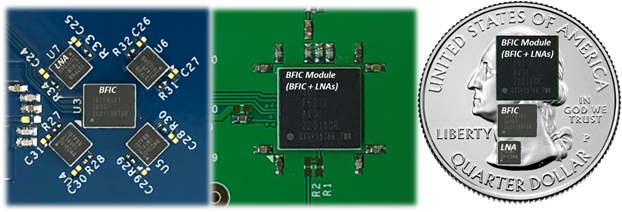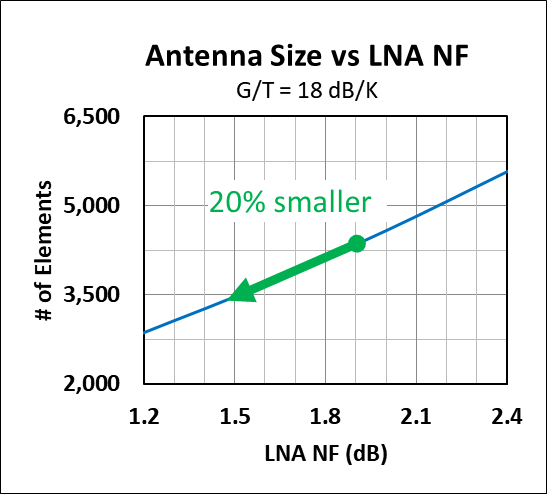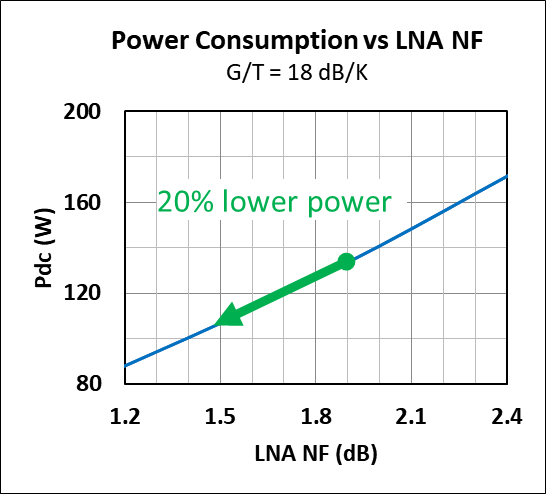In a recent lab test of a new 1.5dB noise figure low-noise amplifier IC in the Ka Satcom Rx band of 17.7GHz to 21.2GHz, we successfully achieved 1.6dB overall cascaded noise figure compared to today’s 2dB state-of-the-art and with only 31mW/ch power consumption. This industry record establishes a new performance benchmark for active beamforming ICs used in Electronically Steered Phased Array Antennas (ESAs) with two simultaneous beams, greatly improving the ESA value proposition compared to less agile, higher weight and single-beam mechanically steered antennas.
The test results from these engineering prototypes are being used to solidify production performance targets for the next-generation products that will be pin compatible with the widely designed-in Renesas F692x, F612x and F62x2 family of Ka-Band Satcom receive ICs (shown in Figure 1). With full interface and pin compatibility, existing customers will be able to upgrade their antenna products to achieve significantly improved noise and power performance with minimal re-design effort and faster time to market.

Figure 1 – Discrete beamforming and LNA ICs of the F612x and F692x product families (left), F62x2 Ka Satcom multi-chip module with heterogeneously integrated beamforming and LNA die (center), all three ICs on a US quarter dollar for size comparison (right).
Impact on System Performance
In satellite communications, achieving desired throughput and capacity is all about the antennas and their electronics. With the EIRP of the satellite fixed, the downward link budget is controlled by the G/T (antenna gain to noise temperature ratio) of the ground terminal antenna. This important figure of merit directly affects the achievable spectral efficiency of the communication link in all applications including in-flight connectivity (IFC), residential/enterprise broadband internet, maritime and satcom-on-the-move (SOTM).
Higher G/T may be realized by increasing the number of ESA radiating elements to achieve higher antenna gain (G). However, this comes at the expense of larger size, weight and power consumption. Another way to improve G/T is by lowering the noise figure of the LNA, which decreases the antenna noise temperature (T). Figure 2 shows the relationship between G/T and LNA NF for an enterprise-grade 58cm / 4,000 element ESA antenna. There is an amplification factor of ~ 2.5:1 of the LNA NF impact on G/T leading to the significant G/T improvement of +1dB (22%) with our newly demonstrated LNA design.

Figure 2 – 25% G/T improvement with new LNA design compared to industry state of the art
For applications where the G/T is already sufficiently high, the improved LNA NF can reduce the size and power consumption of an ESA, by 20% as illustrated in Figure 3 and Figure 4. This reduction is possible because for constant G/T, every tenth dB of LNA noise figure improvement allows for ~5% reduction in element count and power consumption. This in turn reduces the PCB size, BOM count and thermal management complexity leading to lower overall system solution cost.

Figure 3 – 20% fewer elements required with new LNA design compared to current state-of-the-art

Figure 4 – 20% lower power consumption for the same G/T with new LNA design
Note: Calculated relationships presented in Figures 2, 3, and 4 assume a circular antenna aperture with a triangular array lattice sized for grating lobe free operation out to 90deg at Fmax, band-center operating frequency and fixed polarization.
In summary, the LNA is the most critical and impactful component in an ESA flat-panel antenna. Utilizing Renesas’ unique heterogeneously pseudo-lithic IC architecture with separate LNA and beamforming die, allows us to rapidly evolve the complete Rx beamforming solution to address the growing commercial demand for affordable phased array antennas, while also providing design flexibility for novel and diverse antenna architectures.
For more information on our complete portfolio of Satcom solutions, visit renesas.com/satcom.
See our comprehensive portfolio of innovative RF products and design resources at renesas.com/rf.
About the Renesas RF Communications Division
With more than 370 million RFIC devices shipped in the last decade, the Renesas RF Communications division plays a key role in the ongoing communications revolution. Globally known for our unique SNR and linearity enhancing innovations, we are proud to be a trusted partner to the biggest players in cellular infrastructure, satellite communications, and other industrial applications.
